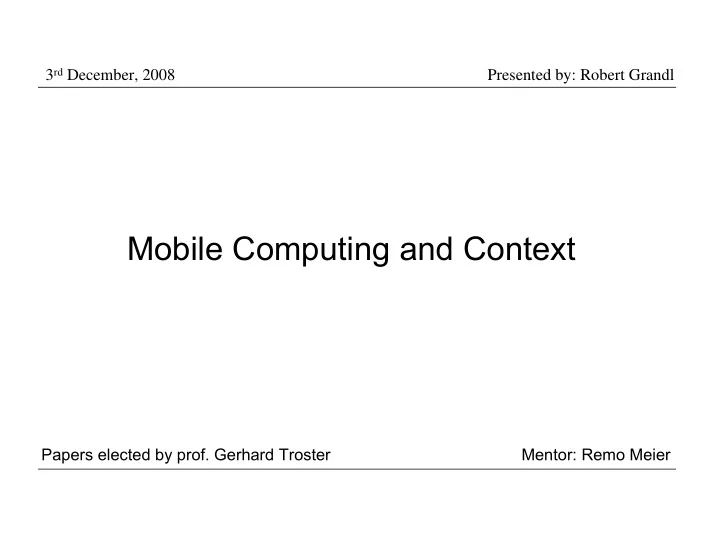

3 rd December, 2008 Presented by: Robert Grandl Mobile Computing and Context Papers elected by prof. Gerhard Troster Mentor: Remo Meier
Table of Contents • Motivation • Main ideas and results in analyzed papers • Conclusions
Motivation � activities recognition by automated systems lead to improvements in our life � approaches build on intelligent infrastructures or use of computer vision � current monitoring solutions are not feasible for a long- term implementation
Activity recognition using on-body sensing Common Ideas Paper 1 and 2
2. Classification “He sleep” - 80% Classifier A: “He learn” - 20% 1. Segmentation “He sleep” - 75% Classifier B: “He learn” - 25% ? Interesting NULL 3. Fusion Classifier A + Classifier B: = He sleep ?
� on-body sensors are deployed strategically � the selection of features and event detection thresholds play a key role � prior training from data is required � to analyze the recognition performance, Precision and Recall metrics were used
� the goal of each recognition approach is to find with higher accuracy true positive events � high impact of false positive and false negative events Multiclass Confusion Matrix
� Classification of NULL is a tough problem for any classifier � Different fusion methods are used for accurate classification: a) comparison of Top Choices (COMP) b) methods based on class rankings Highest rank (HR) Borda Count Logistic Regression (LR) c) agreement of the detectors (AGREE)
Activity Recognition of Assembly Tasks Paper 1
� recognize the use of different tools involved in an assembly task in a wood workshop � recognize of activities that are characterized by a hand motion and an accompanying sound � microphones and accelerometers as on-body sensors
Broken up into segments ` LDA distance and HMM likelihood, carried out over these segments Covert into class ranking; combine using fusion methods I know the truth Overall recognition process
Sound analysis used to identify � relevant segments Using only IA produce fragmented � results A different method of “smoothing” � using majority vote was applied A relatively large window (1.5 s) � was chosen to reflect the typical timescale of interest activities Sound based segmentation
Jamie Ward, Diss. ETH 16520
sound classification acceleration classification need when higher information about a segment is required use the LDA distances; combination of features used to feed provides a list of class distance the HMM models for each segment provides a list of HMM likelihoods for each segment Fusion
Segmentation Results Recall = true positive time TP = ; total positive time TP+FN true positive time TP = Precision = ; hypothesized positive time TP+FP
Continuous Time Results: Recall =correct positive time = correct ; total positive time TP+FN correct positive time = correct Precision = ; hypothesized positive time TP+FP Three methods of evaluation: user-dependent user-independent (most severe) user-adapted Continuous R and P for each Positive Class and the Average of These; User-Dependent Case
Lessons Learned � using intensity differences works relatively well for detection of activities; however, short fragmented segments (apply smoothing) � activities are better recognized using a fusion of classifiers � less performance in user independent case; fused classifiers solve this problem.
� over one billion of overweight and 400 mil obese patients worldwide � several key risk factors have been identified, controlled by dieting behavior � minimizing individual risk factors is a preventive approach to fight the origin of diet-related diseases
Three aspects of dietary activity � characteristic arm and trunk movements associated with the intake of foods � chewing of foods, recording the food breakdown sound � swallowing activity Sensor positioning at the body
� Segmentation using a fixed distance; manually annotation of events � Classification similarity-based algorithm � Fusion COMP, AGREE, LR use of confidence
Performance measurement R = 1 => perfect accuracy P = 1 => 0 insertion errors
Movement Recognition CL DK SP HD
Chewing Recognition Dry Wet
Swallowing recognition We have to work more !
Lesson learned � food intake movements recognized with good accuracy � chewing cycles were identified well; Still low detection performance with low amplitude chewing sounds � it provides an indication for swallowing; Still incurs many insertion errors
Conclusion of Paper 1 and 2 Pluses recognize different activities with good accuracy � concepts used in “real-life” applications � long term functionality � Useful for me
Conclusion of Paper 1 and 2 Minuses a lot of training � sensitive to features & event threshold � selection assumptions on NULL class � uncomfortable systems for long-term use �
However, aspects like user attention and intentionality cannot be picked-up by usually sensors deployed
Recognition using EOG Goggles Paper 3
� Identify eye gestures using EOG signals; � Electrooculography (EOG) instead video cameras; � Steady electric potential field from eyes; � Alternate saccadic eye movement and fixations; � Physical activities leads to artefacts;
1 2 3 4 (1) armlet with cloth bag Hardware architecture of the eye tracker (2) the Pocket (3) the Goggles (4) dry electrodes
EOG gesture recognition blink & saccade detection blink removal stream of saccades events median filter used to compensate artefacts
Eye gestures for stationary HCI Eye gestures of increasing complexity T T : total time spent to complete the gesture T S : success time spent only on successful attempts Acc: accuracy
Eye gestures for mobile HCI � perform different eye movement on a head-up display � investigate how artefacts can be detected and compensated � an adapted filter performs well than a filter using a fixed window (a) – (f) type of filter/medium used
Lesson learned eye gesture recognition possible with EOG � good accuracy of results in static scenarios � artefacts may dominate the signal � more complex algorithms for mobile scenarios �
Conclusion of Paper 3 Pluses treat aspects which encompasses mere than physical activity � much less computation power � Minuses uncomfortable for long-term use � difficult for testing �
Questions ?
Recommend
More recommend